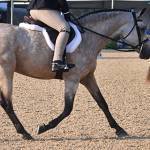Joint Blocks with Lidocaine and Bupivacaine Concerning in Horses

A comprehensive lameness examination often involves “blocking” joints with local anesthetics. If the horse becomes sound after blocking, then that joint is often deemed the source of the pain and lameness. Because local anesthetics are effective, these medications are commonly used; however, research shows that local anesthetics have the potential to initiate inflammatory reactions, which may ultimately harm joint tissues.
According to one study, local anesthetics are toxic to a wide variety of cells, including cartilage cells, or chondrocytes, and may even result in chondrocyte death.* Injection of these agents intra-articularly also induces inflammation within the joint, which can be verified by measuring acute-phase proteins. These proteins increase or decrease in circulation in response to inflammation. Common examples include albumin, haptoglobin, and serum amyloid A.
To compare the inflammatory reactions produced by lidocaine and bupivacaine, the right middle carpal (knee) joints of 20 healthy horses were injected with 5 mL of either 2% lidocaine or 0.5% bupivacaine. The left middle carpal joint in each horse was injected with 5 mL of 0.9% saline as a negative control.
Synovial fluid samples were collected immediately prior to the joint injection and again 12, 24, 48, 168, and 360 hours (15 days) following injection. Inflammatory reactions in the joint were assessed by measuring acute-phase proteins at each timepoint.
“Results showed that a single intra-articular injection of either lidocaine or bupivacaine induced inflammation. The inflammatory reactions were more pronounced for lidocaine than bupivacaine,” explained Catherine Whitehouse, M.S., an advisor for Kentucky Equine Research.
Specifically, significantly greater levels of the acute-phase proteins albumin, transferrin, alpha-1-acid glycoprotein, and haptoglobin were identified in lidocaine-treated joints.
“Inflammation in this study was believed to be caused not only by the local anesthetics themselves but also from the trauma associated with the actual joint injection. Further, saline also induced inflammation but to a much lesser extent than either lidocaine or bupivacaine,” Whitehouse explained.
Horses put a lot of strain on their joints, and this wear and tear can lead to soundness issues that often require veterinarian treatment.
“Oral joint supplements complement veterinary management of joint health by providing chondroprotective compounds as well as antioxidant and anti-inflammatory nutrients,” Whitehouse said.
Kentucky Equine Research has created a line of research-proven joint health products containing ingredients such as glucosamine, chondroitin sulfate, and hyaluronic acid. EO-3 also provides joint support, functioning as an anti-inflammatory compound.
*Dos Santos, G.C., P.A.D. Filippo, L.A. da Fonseca, and C.R. Quirino. 2023. Effects of a single intra-articular injection of 2% lidocaine or 0.5% bupivacaine on synovial fluid acute phase protein concentrations in healthy horses. Journal of Equine Veterinary Science. doi:10.1016/j.jevs.2023.104286.








